                         |
> RECALLING THE BARTER ECONOMY: A BRIEF EXPLANATION
In May 2004, Jack Butler arrived in Baker Lake with approximately five hundred photographs that he shot in this same Northern community in 1969 to 1973. As an opening gesture in the project, the "Art and Cold Cash" Collective formed the intention to bypass the issue of cold cash altogether and return to the barter system, to underline some issues of value by proposing to trade Butler's collection of old photographs for new pictures. The five artists of the Collective pinned more than one hundred photographs to the wall of our drop-in centre and placed the remainder of the collection in stacks on tables. Ruby Arngna'naaq announced our exhibition-for-trade on local radio, inviting anyone interested to take away snapshots from their past in exchange for photographs of Baker Lake now, or more broadly, in exchange for anything they considered to be of equal value. Butler had produced formal photographs in the years 1969 to 73, in order to represent the emerging artists of the newly established Sanavik Co-op to the world beyond Arctic Canada. |
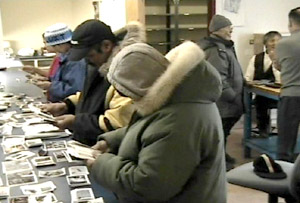 CLICK IMAGE TO VIEW QUICKTIME VIDEO CLICK IMAGE TO VIEW QUICKTIME VIDEO |
However, the collection presented forbarter represented more informal images: Inuit friends and acquaintances, their families, wedding pictures, sculptures, drawings, prints, daily life in the print shop and sewing shop, views of the settlement and the land, details of the tundra, the ice and dog, bird and rodent bones. At the beginning, we were not at all sure that anyone would take up our invitation to barter, but the immediacy of the community's response went far beyond anything we could have anticipated. Surprisingly, the list of objects we received in trade also exceeded our expectations, including the performance of a traditional song, handmade jewelry, and a pork chop dinner. |
|
                         |
RECALLING THE BARTER ECONOMY: TRADING THE PAST IN THE PRESENT
May 24, 2004 to June 20, 2004 |
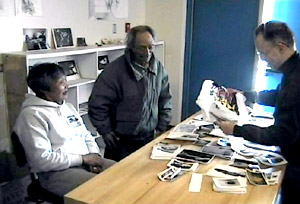
CLICK IMAGE TO VIEW QUICKTIME VIDEO |
In May 2004, Jack Butler arrived in Baker Lake with approximately five hundred photographs that he shot in this same Northern community in 1969 to 1973. As an opening gesture in the project, the "Art and Cold Cash" Collective formed the intention to bypass the issue of cold cash altogether and return to the bartersystem, to underline some issues of value by proposing to trade Butler's collection of old photographs for new pictures. The five artists of the Collective pinned more than one hundred photographs to the wall of our drop-in centre in a back room of the Jesse Oonark Centre and placed the remainder of the collection in stacks |
| on tables. Ruby Arngna'naaq announced our exhibition-for-trade on local radio, inviting anyone interested to take away snapshots from their past in exchange for photographs of Baker Lake now, or more broadly, in exchange for anything they considered to be of equal value. Butler had produced formal photographs in the years 1969 to 73, in order to represent the emerging artists of the newly established Sanavik Co-op to the world beyond Arctic Canada. However, the collection presented for barter represented more informal images: Inuit friends and acquaintances, their families, wedding pictures, sculptures, drawings, prints, daily life in the print shop and sewing shop, views of the settlement and the land, details of the tundra, the ice and dog, bird and rodent bones. |
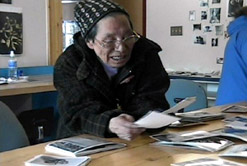 |
In addition to the photos for trade, we enlivened our small rented room by hanging drawings of bones that Patrick Mahon made in the early nineteen eighties from the Arctic community of Chesterfield Inlet, two 1970 drawings produced by Sheila Butler in Baker Lake, two recent works by William Noah and two photo/drawings by Jack Butler representing a traditional Inuit game played with the head bones of a trout. At the beginning, we were not at all sure that anyone would take up our invitation to barter, but the immediacy of the community's response went far beyond anything we could have anticipated. Surprisingly, the list of objects we received in trade also exceeded our expectations. |
Luke Arngna'naaq's was among the most remarkable of the trades. In his seventies himself, he was moved at finding a photograph of his late uncle, the carver George Tatanniq. On contemplating the image he began to recall, and to sing, Tatanniq's personal song. He became deeply involved in recalling the exact words and order of the song and was moved to tears as he sang. We accepted his song performance as more than equivalent to the photograph he took away.
Thomas Iksiraq and his wife Philippa were especially pleased to find a photo of their wedding party thirty years after the event. They explained that they did not have any wedding photos of their own. The wedding party took place in the Sanavik Shop in 1971, complete with drum dance and caribou feast. In exchange, they brought a photo of a recently caught huge trout, so big that in the photos it is supported by Thomas, Philippa and their son, Hosea.
Silas Aittauq, an experienced sculptor, spent a long time viewing the photographs, but in the end he was most impressed by Patrick Mahon's large drawings of a selection of bones. Mahon retrieved these bones from the beach in Chesterfield Inlet when he lived there. Aittauq asked if the drawings were also available for barter and Mahon enthusiastically consented. Although Mahon, as the artist, could not identify the species or skeletal location of the bones, Aittauq, the hunter, knew that the drawing he most admired represented a bone from a bearded seal. Traditionally, this was considered to be a special bone that was given to young boys to reinforce their dog sledding skills. In exchange for the drawing, Aittauq contributed a group photo of his brothers who presently live in different communities. |
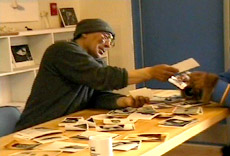
CLICK IMAGE TO VIEW QUICKTIME VIDEO |
William Noah, a member of the Collective, selected several photographs and traded for more than a dozen of his own recent photographs. Some of these were of a particular site called Kitchecut on the banks of the Hermann River, the area where he grew up and where he has been returning annually with his extended family for traditional char fishing with hand-made spears. He also contributed a self-portrait - the artist as photographer - photographing himself in a mirror. Noah's daughter, Clara, was visibly moved by a photo of her late grandmother, Oonark. In exchange for her grandmother's photo, Clara gave us one taken by her father when Clara was a small child. It depicted a pattern of bird bones that she had assembled on the tundra as a childhood game. |
| Veronica Kingilik took two photos of her mother, Irene Neooktuq, in exchange for a photo of Inuit in traditional clothing at the 1994 formal opening of the Kazan Falls historic National Park. Basil Tiktaalaaq found a photo of himself as a child with a group in front of the Sanavik Co-op building, and also two photos from 1970 of the annual summer sealift. He gave us a current portrait shot of himself wearing a Detroit Redwings hat and jacket. It would be too lengthy to describe all the "trade goods" that have been exchanged, but a brief account must include a very tiny stone sculpture by Tuna Irkuliq, two stencil prints by Simona Scottie, and handmade caribou bone earrings from Martha Noah in exchange for drawings by Sheila Butler and Patrick Mahon. |
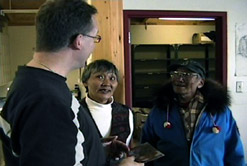 |
Another noteworthy example concerns a trade by Silas and Lucy Arngna'naaq, who delivered to our drop-in centre a much appreciated "take-out" pork chop dinner in exchange for a portrait of the respected leader Anguhadluq, a group shot of printmakers outside the Sanavik Co-op building, and photos of other relatives. Trading the past in the present continued at random times every day and evening, in the context of many interesting conversations arising from the exchange, some in English, some Inuktitut/English facilitated by the interpretive skills of Ruby Arngna'naaq and William Noah. |
|























































